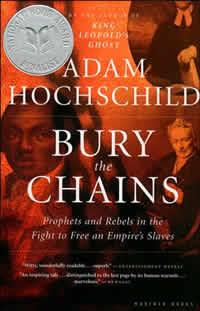Book Notes
 Adam Hochschild, Bury the Chains; Prophets and Rebels in the Fight to Free an Empire's Slaves (New York: Houghton Mifflin, 2005), 468pp.
Adam Hochschild, Bury the Chains; Prophets and Rebels in the Fight to Free an Empire's Slaves (New York: Houghton Mifflin, 2005), 468pp.
Beginning in 1555 and lasting for 350 years, the British empire bought, sold, and enslaved about 11 million African people. This required some 35,000 voyages along the so-called triangular trade route: buying slaves from African slave traders along the continent's west coast, depositing their human cargo mainly in the Caribbean to work on Britain's sugar plantations but also to ports from Quebec to Chile, and then returning to England with imports for the empire. At the end of the 18th century slavery was hardly unusual; it was the rule for most peoples and places on earth. What was unusual was that in the space of about fifty years Britain outlawed the slave trade, and then a while later slavery itself (abolition was one thing, genuine emancipation another).
How did the unthinkable happen? How did an economic system that was so deeply embedded, so profitable, and so taken for granted as normal by almost everyone, disappear so swiftly? Hochschild describes the abolition movement as "one of the most ambitious and brilliantly organized citizens's movements of all time." Many of the political means that we enjoy today were perfected back then—investigative journalism into the real conditions of slave life, sugar boycotts, 519 petitions to the British parliament with 390,000 signatures, public debates, media campaigns, and every day activism. Progressive women's groups far ahead of their time, missionaries (despised by the plantation owners), British evangelicals, Methodists, and especially the culturally marginal Quakers all provided principled moral argument. The herculean efforts of Thomas Clarkson, the parliamentary leadership of William Wilberforce, and the legal advocacy of the eccentric Granville Sharp were essential.
But Hochschild is careful to avoid the paternalism of self-congratulatory, aristocratic benevolence. After all, when all was said and done, it was the slave-owning planters who were reimbursed for their "losses" by the British government and not the slaves. Whenever possible he allows the slaves to speak for themselves, like the remarkable Olaudah Equiano, whose 500-page best-selling autobiography Interesting Narrative provided a first person narrative of what is still considered the best account of slave life (and is still available today); and Quobna Ottobah Cugoano's Thoughts and Sentiments on the Evil and Wicked Traffic of the Slavery and Commerce of the Human Species. He describes at great length the numerous slave revolts in which fearless and skilled leaders like Toussaint L'Overture led slaves to free themselves and force the British to face reality, however reluctant they were to do so. In these violent and vicious revolts the most beleaguered people on earth defeated the world's two greatest military powers, France and Britain, in Haiti and Jamaica.
Bury the Chains joins Hochschild's previous book King Leopold's Ghost: A Story of Greed, Terror, and Heroism in Colonial Africa (1999) about Belgium's plunder of the Congo. The stories are depressing but inspiring, for however dark these histories, however deep our national complicity, the narratives remind us that we are nor fated to accept injustice to our fellow human beings. Whether in Iraq or Darfur, whether with malaria or HIV-AIDS, the abolition of slavery reminds us that effective movements of genuine social justice are possible.


